Thursday 4 June 1942
 |
| "The U.S. Navy aircraft carrier USS Yorktown (CV-5) lists heavily after she was abandoned during the afternoon of 4 June 1942. Note that two Grumman F4F-4 Wildcat fighters of Fighting Squadron 3 (VF-3) are still parked on her flight deck, aft of the island." Naval History and Heritage Command 80-G-21666. |
Battle of the Pacific: Japan loses three aircraft carriers on 4 June 1942 during one of the pivotal days of World War II.
The day begins with the Japanese Fleet approaching Midway Island and three U.S. Navy aircraft carriers, unknown to the Japanese, waiting for them to the northeast of the island. Reveille on Midway sounds a 03:00, with battle stations ordered. At 04:00, six F4F Wildcats of VMF-221 (Major Floyd B. “Red” Parks) take off, followed by 11 PBY Catalinas of VP-44. In addition, 16 B-17 bombers get in the air, ready to bomb the Japanese.
Initial Japanese Carrier and Midway Island Aircraft Attacks
On the Japanese side, Vice Admiral Chuichi Nagumo’s First Striking Force, composed of fleet carriers Akagi, Kaga, Hiryu, and Soryu, begin launching their aircraft at 04:30. By 04:45, 36 Nakajima B5N2 Kate torpedo bombers, 36 Aichi D3A1 Val dive bombers, and 36 Mitsubishi A6M2Zero fighters were on their way to Midway.
A U.S. pilot, Lieutenant Howard P. Ady, spots the approaching Japanese planes at 05:30 and gets off a detailed radio report. Radar on Midway picks up the Japanese planes at 05:53. This alerts the defenders, who rush to man their positions. Twenty-one Buffalo fighters, six Wildcats, six TBFs, and four B-26 bombers follow suit, along with all available dive bombers. Every one of the 66 planes based at Midway is in the air by 06:16.
The Buffaloes and Wildcats intercept the approaching Japanese bombers. The Japanese Zeros make quick work of the first six Buffaloes, destroying all but one that barely limps back to Midway. The Zeroes then begin picking off the remaining Buffaloes, opening a path for their bombers, losing three Kate bombers in the process.
 |
| Oil tanks burning on Midway Atoll after the Japanese attack, 4 June 1942. Note the birds in the foreground. (US National Archives). |
At 06:31, the Japanese are over Midway Island and the anti-aircraft guns on the island open fire. The Kate bombers destroy three oil tanks and set fire to a seaplane hanger while losing two of their number. Val dive bombers attack the airfield, killing four mechanics and setting off eight 100-lb bombs and some .50-caliber ammunition. The island's electricity goes out when a Val bombs Eastern Island's powerhouse. This causes a real interruption of the island's water supplies, as opposed to the fake problem radioed by Midway Island in May that enabled U.S. Navy cryptographers to pinpoint Midway as the Japanese objective.
The attack is over by 06:48, and the all-clear sounds at 07:15. Only six Buffalo fighters make it back to the island and only 20 of the original force of U.S. fighter planes. They are almost all badly damaged, with one Buffalo and one Wildcat still serviceable. Casualties on the ground are 11 dead and 18 wounded.
Meanwhile, Midway's own bombers find the Japanese carriers and launch their own attack at 07:10. Six TBFs attempt a torpedo run but five are shot down by defending Zero fighters. Only one TBF launches its torpedo at a cruiser and then barely makes it back to the island.
Four B-26 Marauder bombers then attack. Two get within 850 yards and 450 yards, respectively, of carrier Akagi and launch their torpedoes. Only two of the Marauders survive the defending fighters. The torpedo attacks have done one thing extremely well, however, in that they have drawn the defending fighter cover down to sea level.
At 07:48, sixteen Dauntless and Vindicator dive bombers of VMSB-241 (Major Lofton Henderson) arrive at the scene and begin their attacks. The fighters quickly get up to 4000 feet and begin shooting down the arriving planes, but there is enough cloud cover for the U.S. planes to evade most of the attacks. The Zeros shoot down Henderson's Dauntless, but ten get through to drop their bombs at low altitude. The planes then return to Midway, losing eight SBDs in total and with only six making it back to base.
Next, 15 B-17 Flying Fortress bombers led by Lt. Col. Walter C. Sweeney arrive at 08:10, just as the Dauntlesses are completing their attacks. These bombers have no success, finishing their attack by 08:20 and returning to Midway.
Just as the B-17s are completing their bomb runs, 11 Vindicators (Major Benjamin Norris) arrive and are immediately swarmed by Zero fighters. They attack battleship Haruna, losing two planes to anti-aircraft fire and three others on the way back to Midway. These attacks also completely fail.
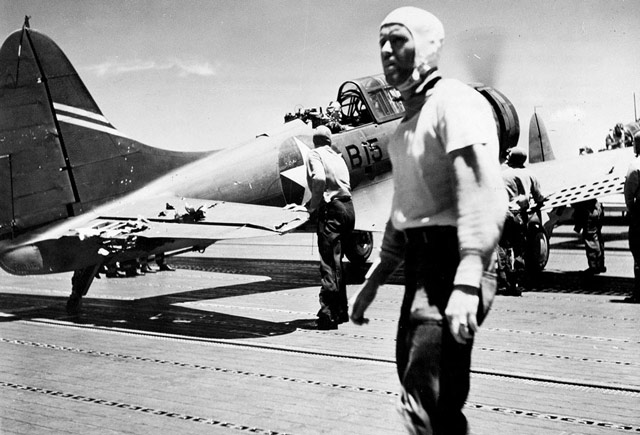 |
| A battle-damaged SBD from carrier USS Enterprise on the flight deck of carrier USS Yorktown after having to land there due to fuel exhaustion, 4 June 1942 (US Naval History and Heritage Command). |
At this point, in mid-morning, the U.S. attacks have achieved no hits on the Japanese ships despite a wave of attacks. They have lost 19 planes, and only six Dauntlesses, seven Vindicators, one Buffalo, and a single Wildcat remain usable on Midway. The Japanese essentially have beaten the defenders of Midway Island and it is ripe for invasion.
However, the presence of three U.S. Navy aircraft carriers (USS Yorktown, Enterprise, and Hornet) remains unknown both to the island's defenders and to the Japanese. Admiral Nagumo is convinced that he has defeated the Americans, so he throws caution to the winds and has his reserve force armed with contact bombs for use against land targets to soften the island's defenders up for his invasion.
However, midway through this process, at 07:40, a scout plane from cruiser Tone reports that it has sighted a U.S. fleet to the east. Critically, the pilot does not mention that there are any aircraft carriers, and the report does not reach Nagumo until 08:00. He immediately orders the bombs changed to general-purpose bombs.
Massive confusion now overcomes the Japanese commanders. Nagumo knows he has must recover his planes from the morning strike against Midway Island before launching any attacks on the U.S. ships, which he thinks are almost all non-carriers (the Tone pilot eventually reports seeing only one carrier). Bringing up his reserve planes from the hangar to the flight deck and launching them would take 30-40 minutes, and the strikes still would go off in a ragged fashion. Torn between sending an immediate strike or recovering his planes from the Midway raid, Nagumo ultimately decides on the latter. This also would give his crew time to arm the reserve planes with torpedoes.
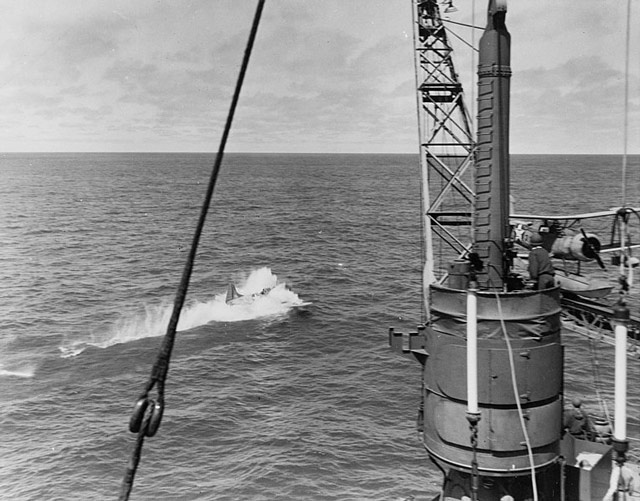 |
| "U.S. Navy LCdr Maxwell F. Leslie, commanding officer of Bombing Squadron 3 (VB-3), ditches his Douglas SBD-3 Dauntless next to the heavy cruiser USS Astoria (CA-34) after successfully attacking the Japanese carrier Soryu during the Battle of Midway, 13:48 hrs, 4 June 1942." Naval History and Heritage Command 80-G-32307. |
U.S. Navy Carrier Attacks
Meanwhile, on the U.S. Navy side, there is no indecision at all. Admiral Frank Fletcher launches his planes beginning at 07:00 and completes this by 07:55 for Enterprise and Hornet and by 09:08 for Yorktown. The planes are well on their way toward the Japanese ships while Nagumo is making up his mind.
The U.S. carriers are roughly 155 nautical miles (287 km, 178 miles) from the Japanese carriers at launch. The planes from Enterprise and Hornet do not form up, but instead, fly piecemeal toward the targets. Some of the planes follow an incorrect heading and miss the carriers, having to ditch, but one formation of TBD Devastator torpedo bombers (Torpedo Squadron 8, or VT-8 (Lt Cdr John C. Waldron) heads on the correct heading.
Waldron's planes arrive over the Japanese carriers at 09:20 and immediately attack. Unfortunately, they have no fighter escort and the defending Japanese Zeros shoot down all 15 Devastators before they can make any hits (one ensign survives after launching a torpedo that misses carrier Sōryū).
At 09:40, VT-6 from Enterprise, composed of 14 Devastators, arrives and attacks. It fares only a little better, losing nine planes without any hits. At 10:10, another wave of Devastators (VT-3 from Yorktown) arrives and 10 of these 12 planes also are shot down. So far, the defending Japanese combat air patrol is having a field day and the Japanese fleet remains unscathed despite all the attacks. Zero fighters clearly outclass the obsolete U.S. Navy torpedo bombers. Another problem for the attackers is that their torpedoes seem surprisingly ineffective given how close some of the planes get to the carriers.
However, everything is not as it seems. As in the earlier attacks, the torpedo attacks have drawn the defending Zeros down to sea level. The carriers, meanwhile, have had to execute extreme maneuvers to evade the torpedo attacks and are out of position. Furthermore, the defending fighters are low on fuel and ammunition.
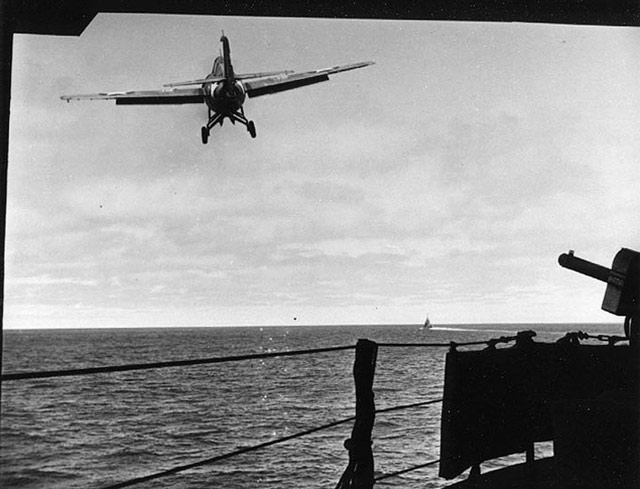 |
| Lt. (jg) William Leonard’s F4F-4 Wildcat taking off from carrier USS Yorktown during Battle of Midway, 4 June 1942 (US National Archives). |
The stage is now set for one of the epic attacks in naval history.
Air Group Commander C. Wade McClusky, Jr. from Yorktown commands three dive-bomber squadrons from U.S. carriers (VB-6, VS-6, and VB-3). McClusky knows his SBD dive bombers are running low on fuel due to heading on the incorrect course. However, he does not give up looking and by chance spots a lone Japanese destroyer sailing toward the Japanese fleet and pointing at it like an arrow. The planes are so low on fuel that some have to ditch before they make it to the Japanese carriers.
However, fortune smiles on McClusky. He splits his planes up to attack carriers Kaga and Akagi. Despite some confusion and miscommunication, the dive bombers attack both carriers within minutes of each other. Basically, Kaga is attacked by two squadrons of dive bombers while Akagi is attacked by one.
It is at this point that the Japanese luck runs out. Their defensive aircraft are out of position, the carriers are full of planes being fueled and armed, and the carriers themselves are poorly protected by their accompanying ships because of the evasive maneuvers they have been forced to make to evade torpedo attacks.
Three to five 500-lb bombs hit their mark on Kaga, starting fires and hitting the bridge, killing Captain Jisaku Okada and most of Kaga's senior officers. This leaves the ship leaderless and out of control. The carrier deck tears and bends into the air, exposing the hangar deck and its fueling aircraft to more bombs.
 |
| "The End of Akagi." Painting by John Hamilton (1919-1993), original is displayed in The Pentagon, Washington, D.C. |
Due to miscommunication, only three dive-bombers led by Lieutenant Richard H. Best, who has decided not to attack Kaga because it is blowing up, attack Akagi. The bombers have unbelievable luck, as there is almost no defensive fire. One of the bombs hits the edge of the mid-ship elevator and penetrates to the hangar deck, where it explodes. The armed and fueled aircraft there detonate in a fireball, creating an explosion that rips the interior of the carrier apart. The crew has no hope of bringing the raging inferno under control.
VB-3 (Max Leslie) sees Kaga and Akagi blowing up and, still armed, now turns its attention toward a third carrier, Sōryū. They achieve at least three hits, igniting the gasoline being used to fuel the planes and detonating ammunition as with the other two carriers. VT-3 attacks the fourth carrier, Hiryū, but has no luck.
The fires on Akagi, Sōryū, and Kaga seal their fates. The fires expand and cause more bombs and fuel to explode and burn. Admiral Nagumo leaves Akagi and transfers his flag to light cruiser Nagara. The Japanese give up on all three carriers and scuttle them.
 |
| USS Yorktown listing and about to sink, 4 June 1942 (US Navy). |
Japanese Counterattack
With three of his four carriers gone, Nagumo orders Hiryū to launch its own immediate attack on the U.S. carriers with whatever is available. It sends 18 D3A Vals and six fighter escorts, a relatively small attack considering the forces battling earlier but the most the Japanese fleet can now muster. The planes follow the retreating U.S. planes back to their carriers and immediately attack when within range. The dive bombers sight Yorktown first and attack it, hitting it with three bombs. The Japanese lose 13 dive bombers and three fighters in this attack.
The damage does not seem too bad at first, with all but one boiler put out of operation and a hole in the flight deck. However, it is bad enough for Fletcher to transfer his own flag to heavy cruiser Astoria.
Yorktown's crew works quickly. They patch the flight deck and get several boilers back in operation within an hour. Soon, Yorktown is steaming at 19 knots (22 mph, 35 km/h) and everything seems under control. It resumes air operations and Captain Buckmaster gets a little cocky, hoisting a huge American flag from the foremast and returning operations to normal.
An hour later, the second wave of Hiryū planes arrives. This is composed of ten Nakajima B5N torpedo bombers and six escorting Zeros. Again, this is not much of an attacking force, but the U.S. defense are strained from the earlier attacks and they hit Yorktown with two torpedoes. The Japanese lose five more bombers and two Zeroes in this attack. Yorktown is left afloat but in very poor condition.
The few Japanese planes that make it back to Hiryū report having sunk two U.S. carriers. They mistakenly believe that the first and second waves attacked different carriers, when, in fact, both hit Yorktown. Nagumo believes that if he can launch one more coordinated attack, he can sink the third and last U.S. carrier, leaving him with the sole remaining carrier near Midway and able to complete the invasion of the island.
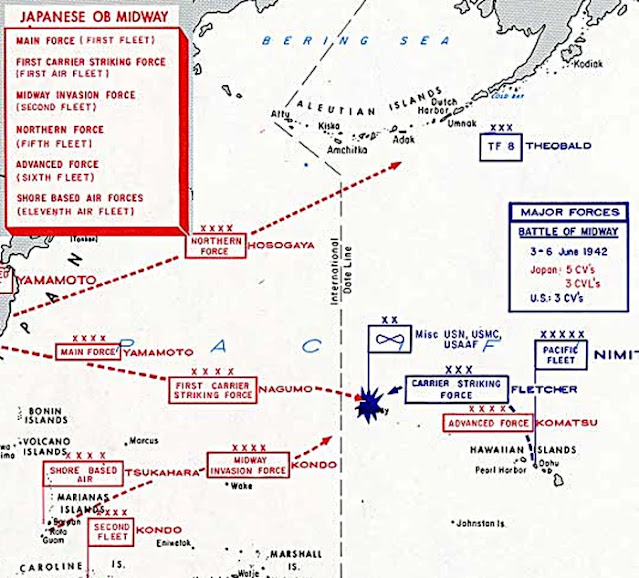 |
| The general outline of the Battle of Midway. Source: United States Military Academy, Department of History. |
The Final U.S. Counterattack
Fletcher and Admiral Spruance, in tactical command of Enterprise and Hornet, are ready to launch their own attack on Hiryū, but first they have to know where it is. Fortuitously, a Yorktown scout plane sights it late in the afternoon and the Enterprise immediately gets a strike force in the air. It is composed of 24 dive bombers (six SBDs from VS-6, four from VB-6, and 14 of VB-3 recovered from Yorktown.
The 24 dive bombers finish the day's work by blowing through the defending 12 Zero fighters and hitting Hiryū with four or five bombs. The same pattern as earlier repeats, with the bombs setting the Japanese carrier ablaze and the fires quickly getting out of control. The damage is so obviously bad that a later raid by Hornet's aircraft decides to skip Hiryū and attack other ships, though with no success.
All four Japanese carriers are now flaming wrecks and must be scuttled (Akagi, Kaga, Soryu) or sink unaided (Hiryū). On the U.S. side, the only carrier that has been hit is Yorktown, but, following the two torpedo strikes, it now is a total loss. The crew abandons ship and it, too sinks. That leaves the score at one U.S. Navy carrier lost to all four Japanese carriers sunk. The U.S. still has two carriers completely undamaged and incorporating planes recovered from Yorktown in addition to their own.
As night falls, the Japanese ships attempt to find the U.S. ships and bring them to battle. Spruance, now in command of operations because Fletcher cannot command from a cruiser, decides the better part of valor is a hasty retreat to the east. The day ends with Yamamoto's heavy ships chasing the U.S. carriers to the east but never spotting them.
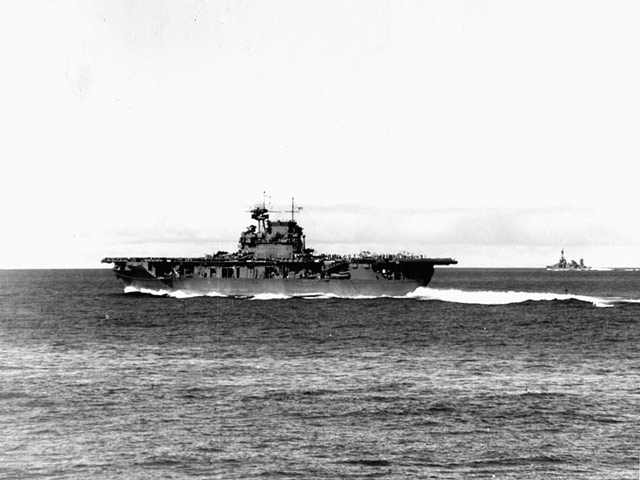 |
| "The U.S. Navy aircraft carrier USS Enterprise (CV-6) steaming at high speed at about 0725 hrs, 4 June 1942, seen from USS Pensacola (CA-24). The carrier had launched Scouting Squadron Six (VS-6) and Bombing Squadron Six (VB-6) and was striking unlaunched SBD aircraft below in preparation for respotting the flight deck with torpedo planes and escorting fighters. USS Northampton (CA-26) is in the right distance, with SBDs orbiting overhead, awaiting the launch of the rest of the attack group." Naval History and Heritage Command 80-G-32225. |
Aleutians Campaign
Things go much better for the Japanese further north.
Following a successful raid on Dutch Harbor in the Aleutian Islands on 3 June, Japanese Vice Adm. Boshiro Hosogaya sends off a second raid from his carriers Junyō and Ryūjō. The attacking planes get through again, destroying oil storage tanks and damaging a hospital and a beached barracks ship. U.S. Navy Task Force 8, under the command of Rear-Admiral Robert A. Theobald, is nearby but does not intervene. Only late in the day do U.S. forces locate the two light Japanese carriers, but their attempts to sink them fail due to poor weather. The weather does help the Americans, though, because it causes the Japanese to cancel plans to invade Adak Island. Instead, they now plan only to land troops at Attu and Kiska. U.S. 3094-ton passenger/barracks ship Northwestern, bombed and damaged during the 3 June raid, is declared a total loss.
U.S. 15-ton halibut schooner King Fisher sinks from unknown causes five nautical miles (9.3 km, 5.8 miles) off Lazaroff Island and Pilot Point, Alaska. There are one survivor and three dead, the survivor rescued by a U.S. Navy patrol boat.
I-27 torpedoes and sinks 3353-ton Australian iron-ore carrier Iron Crown in the Bass Strait. There are 37 deaths. This sinking, combined with one on 3 June by I-24, convinces the Australian authorities to restrict shipping north of Melbourne until they can institute a convoy system on the east coast.
Battle of the Indian Ocean: HMS Trusty (Lt. Cdr. E. F Balston) torpedoes and sinks the 7031-ton Japanese merchant cargo ship Toyohashi Maru in the Strait of Malacca. Casualties are not recorded.
The Tenth Air Force sends two heavy bombers to attack Rangoon, Burma. The ten defending Japanese fighters shoot down one of the bombers and badly damage the other. This is the last raid on Rangoon for some time, as the monsoon rains ground the heavy bombers on their dirt runways.
The 11th Bombardment Squadron (Heavy), 7th Bombardment Group (Heavy) is established with B-25 bombers at Kunming, China.
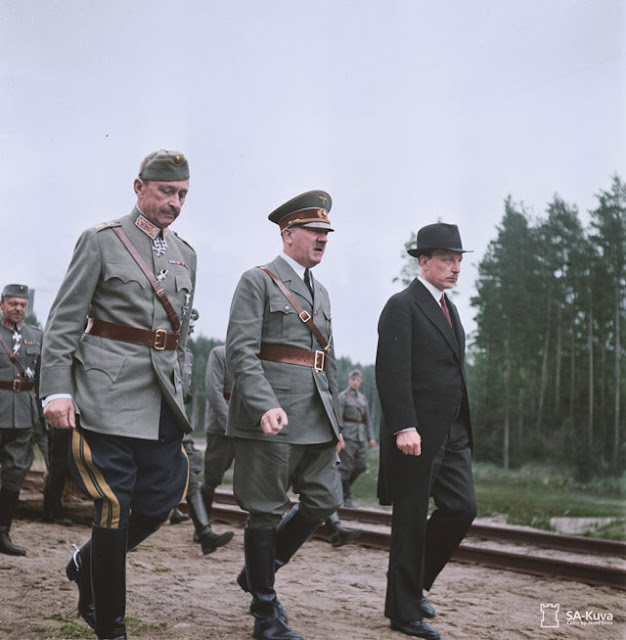 |
| Field Marshal Carl Mannerheim, Adolf Hitler, and Finnish President Ryti walk to Mannerheim's command train parked in a forest, 4 June 1942 (Finnish Military Museum SA-Kuva). |
Eastern Front: At Sevastopol, the Wehrmacht bombardment continues unabated. The rolling barrage shifts today to the line facing the Romanian troops in the east. the Luftwaffe remains very active, flying hundreds of sorties.
Overall, it is a quiet day on the Eastern Front. With Hitler away and nothing going on, General Franz Halder doesn't even bother listing a daily summary in his war diary, simply noting that he is flying to Berlin. When the Fuhrer's away, the mice will play.
Of much greater importance is what Adolf Hitler is doing. While seemingly an informal visit to a friend, it actually is a calculated attempt to shore up the Reich's fraying "co-belligerency" with Finland. The Finns are fighting the same enemy, the Soviet Union, but increasingly are refusing to engage in battles desired by the German high command. Hitler decides a little personal diplomacy is in order.
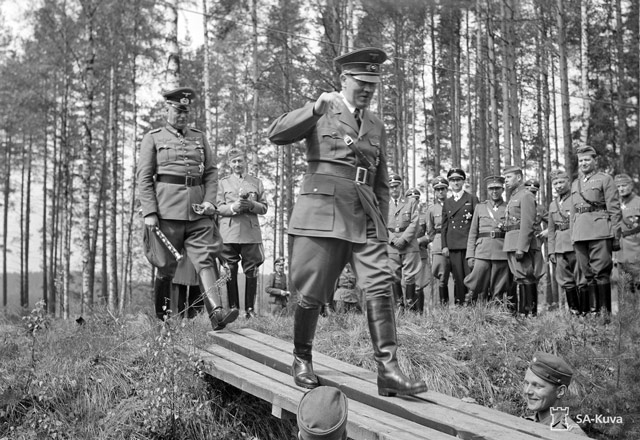 |
| Adolf Hitler, followed by Field Marshal Keitel, "walks the plank" to Finnish Field Marshal Carl Mannerheim's command train. Mannerheim can be seen smirking in the background (SA-Kuva). |
Hitler, seemingly on a whim and with only one day's notice, flies to Finland to wish Field Marshal Carl Mannerheim a happy birthday on 4 June 1942. It is Mannerheim's 75th birthday. The visit is a very rare journey outside the Reich for Hitler, who almost never leaves areas of German control. While Hitler does eventually establish a headquarters in the occupied Soviet Union and visited Vichy France in 1940, German troops are always nearby. Finland is a co-belligerent but by no stretch of the imagination is under German control except in isolated areas such as the far north.
Hitler is greeted warmly by Mannerheim and treated properly, but the visit causes the Finns a great deal of anxiety. For one thing, it complicates Finland's diplomatic relations with the United States, with whom Finland is not at war. Mannerheim purposefully does not greet Hitler at his headquarters, but rather says that he is "in the field" and that Hitler should visit him where his command train is parked, at Imatra in Southern Finland.
Hitler's Focke-Wulf Fw 200 Kondor flies across the Gulf of Finland in great secrecy. When it lands at the small Immola Airfield (about 9 kilometers (6 mi) northeast of Imatrankoski), hard use of the brakes causes an issue with the left landing gear. A fire breaks out, apparently caused by brake fluid spraying over the hot brakes. The Kondor is known to have poorly designed brake hubs, causing the brakes to lock sometimes. Fortunately for Hitler, the fire is quickly extinguished with a fire extinguisher, the damage is slight, and the aircraft is quickly repaired (new bolts are quickly manufactured and installed). Hitler completely ignores the incident and may, in fact, not even know about it.
There are some odd moments during the visit, which lasts much of the day. For one thing, Mannerheim has Hitler and Field Marshal Wilhelm Keitel walk a plank from a hillside to his command train. Both men navigate it without incident, but this could have ended in an embarrassing disaster. Another peculiar moment is when an SS officer bursts into the carriage where Hitler and Mannerheim (along with Finnish State President Risto Ryti and Keitel) are discussing strategy to inform them that Finnish intelligence has been taping their conversation with a hidden microphone. The microphone is located and disabled.
Fortunately for posterity, the 11-minute recording (on a phonograph record) survives the war despite Finnish assurances that it will be destroyed or remain sealed. It is rediscovered (mislabeled) and later released to the public. It is a rare recording of Hitler using his normal speaking voice, as opposed to the louder and more strident voice he uses during speeches. While there is some question whether the recording is genuine, an official investigation verified it.
During the conversation, Hitler confides why he invaded the Soviet Union. He says that he had nightmares of the Romanian oil fields, the source of most of the Reich's oil, "burning from end to end" due to Soviet attacks. To Hitler, Operation Barbarossa is a defensive operation to protect essential assets from a Soviet attack. He admits to being surprised by the Soviet ability to produce so many tanks.
Hitler leaves the meeting and flies back to Germany late in the day, blissfully unaware of the fateful events occurring in the Pacific.
 |
| Adolf Hitler arrives in Finland and is greeted by President Ryti on 4 June 1942. Hitler's Focke Wulf Fw-200 Kondor is in the background. |
European Air Operations: The Luftwaffe engages in scattered bombing and mine-laying around Durham County, Yorkshire, and in general the northeast of England. The bombers show poor accuracy and drop bombs in fields west of Ryhope and at Tunstall Poultry Farm and the Turnstall Burdon District in Durham. Other bombs fall on a golf course and along the foreshore at Seaton Carew and Seaton Snooks. Many of these bombs are delayed-action bombs that must be handled by bomb experts and safely exploded. Other bombs fall in the riverside area near Sunderland. There are two men wounded and minimal damage, though an unexploded bomb does delay the loading of two coaling ships.
Both sides lose a plane over the Waddenzee today. The RAF shoots down a Junker Ju 88 over the Waddenzee 1 km south from Ameland Island. All four men aboard perish. Meanwhile, night-fighter pilot Oblt. Zur Lippe Weissenfeld of II/NJG 1 shoots down a British Wellington III from Marham on a raid to Bremen. All five crewmen perish.
Luftwaffe bombers attack and sink 555-ton British patrol boat HMY Sona (FY 027) off Poole Quay, Dorset, England. The ship poses a hazard to navigation, so it later is raised and sunk at Handfast Point.
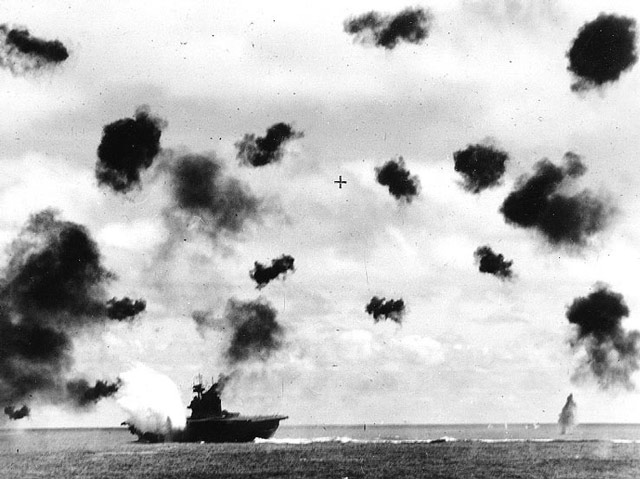 |
| USS Yorktown (CV-5) immediately after an aerial torpedo hit, 4 June 1942. The sky is full of planes and anti-aircraft bursts (U.S. Navy). |
Battle of the Atlantic: German raider Stier, operating 200 miles east of St. Paul's Rocks off the coast of Brazil, spots 4986-ton British freighter Gemstone. It fires a warning shot across the bow, but Gemstone does not stop. Instead, it heads directly away from Stier and tries to make a run for it. However, Stier does not give up and continues firing. Eventually, the Gemstone's crew abandons the ship, which is carrying iron ore. The Stier makes the crew prisoners of war and sinks Gemstone with a torpedo.
U-158 (Kptlt. Erwin Rostin), on its second patrol out of Lorient, torpedoes and sinks 2647-ton Norwegian freighter Nidarnes in the Yucatan Strait (southwest of Cuba). Nidarnes is carrying military stores to Brazil and sinks within a minute, with the 11 survivors (13 dead) having to literally jump for their lives as the ship goes under. Someone manages to launch a raft, which the survivors reach a few hours later. They are picked up later in the day by U.S. freighter Curaca.
German 7978-ton freighter Katharina Dorothea Fritzen hits a mine and sinks near Borkum. Casualties are not recorded.
Battle of the Mediterranean: The two opposing field commanders in Libya, German General Erwin Rommel and British General Neil Ritchie, spend the day resupplying and preparing offensive operations. RAF Desert Air Force (DAF) fighters and fighter-bombers have a mixed day, scoring some success against Luftwaffe Junkers Ju-87 dive bombers and destroying some Axis vehicles, but losing seven planes.
The Free French troops under General Kœnig continue to hold out at Bir Hakeim, disrupting Rommel's plans to sweep east toward Tobruk. He is grateful for the support of the DAF, which is destroying Axis vehicles surrounding his fortress, so he sends Air Vice-Marshal Arthur Coningham the message, "Bravo! Merci pour la R.A.F" Coningham responds in kind, "Merci pour le sport." However, all is not rosy on the Allied side, as Kœnig's men are surrounded and running low on water and other supplies.
German submarine S-57 torpedoes and sinks 305-ton Royal Navy anti-submarine ship HMS Cocker off Tobruk, Libya. There are 15 dead and 16 survivors.
RAF aircraft torpedo and badly damage 6837-ton Italian freighter Reginaldo Giuliani 120 miles northeast of Benghazi. An Italian destroyer, Partenope, later scuttles it. Casualties are not recorded.
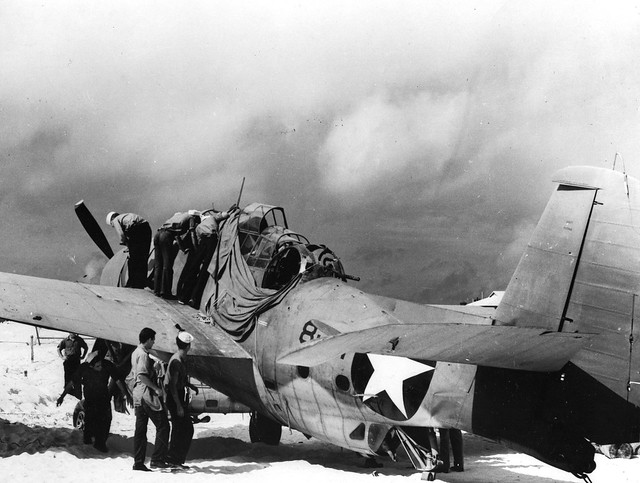 |
| The badly damaged aircraft of Lt(jg) Albert Earnest, the sole survivor of VT-8 during a morning attack on the Japanese Fleet, after landing at Midway (U.S. Navy). |
Special Operations: Eight days after being wounded during an assassination attempt, Reinhard Heydrich dies in a Prague hospital. Heydrich for a time appeared to be improving, but lapsed into a coma on 3 June and never regained consciousness. The cause of death is variously attributed to sepsis and an embolism. The Germans plan a massive funeral for 7 June.
Heydrich's death makes the British/Czech Operation Anthropoid a resounding success. The two Special Operations Executive agents who staged the attack on him, Jan Kubiš and Jozef Gabčík, remain at large but are the subject of an intense manhunt. The two men are hiding out in Czech safe houses, but the Germans have offered both inducements and threats for his capture. At least one Czech resistance member knows their whereabouts and is planning to reveal it to the Germans.
U.S. Military: Brigadier General Lucian K. Truscott, Jr. (Chief of the American Section attached to the Combined Operations Headquarters) completes an inspection of Northern Ireland. He submits a report on plans to activate the 1st Ranger Battalion at Carrickfergus. Lieutenant General Breton Somervell, Commanding General of the Army Service Forces, also carries out an inspection in Northern Ireland.
American Homefront: Metro-Goldwyn-Mayer releases "Mrs. Miniver," starring Greer Garson, Walter Pidgeon, and Teresa Wright. It is the highest-grossing film of 1942 and earns six Academy Awards, including Best Picture, Best Director (William Wyler), and Best Actress (Garson). Teresa Wright, who was nominated for a Best Supporting Actress Oscar for her debut film "The Little Foxes" and also as Best Actress for 'Pride of the Yankees" for work in 1941, this time earns the Best Supporting Actress Oscar. It is one of the most dazzling debuts by any actor or actress in history, but her success quickly peters out after this and "Mrs. Miniver" is her last nomination.
2021
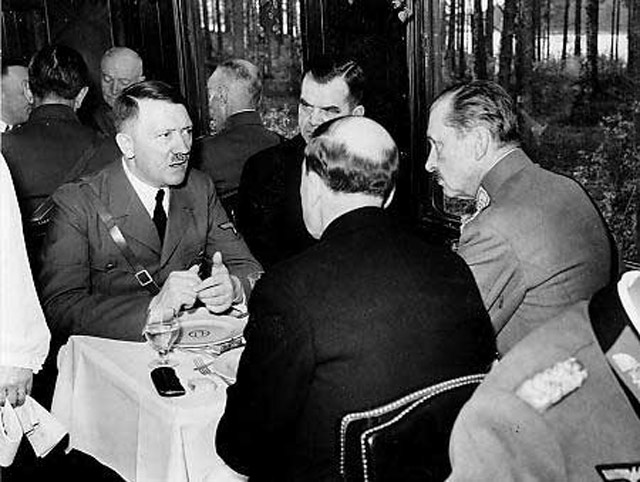
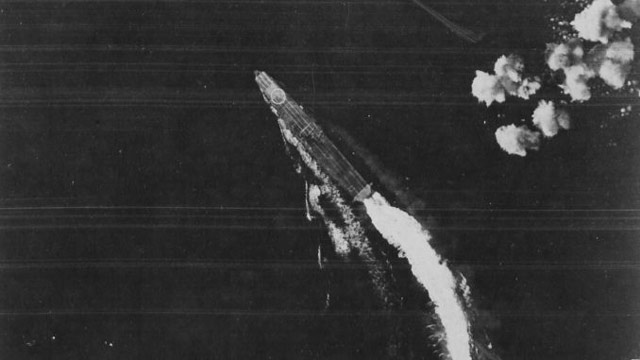

No comments:
Post a Comment